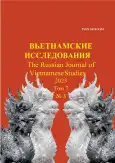Vietnamese phraseological units with a numeral component
- Authors: Andreeva V.A.1
-
Affiliations:
- Institute of Linguistics of the Russian Academy of Sciences
- Issue: Vol 7, No 3 (2023)
- Pages: 75-83
- Section: Scientific researches
- URL: https://ogarev-online.ru/2618-9453/article/view/131436
- DOI: https://doi.org/10.54631/VS.2023.73-112542
- ID: 131436
Cite item
Full Text
Abstract
The article is devoted to the study of structural and semantic features of phraseological units with a numeral component in the Vietnamese language. It is noted that the numeral components in the phraseological units can both retain their quantitative meaning and be subjected to partial or complete desemantization. The most productive numeral components of phraseological units in the Vietnamese language are quantitative numerals of the first ten, while the largest number of set expressions are with the numeral một “one”. In the vast majority of Vietnamese phraseological units, several numerals are used simultaneously, usually two. This is due to the application of the principle of parallelism in the construction of most phraseological units. With the opposite use of numerals, it is possible both to use the same numeral several times, and to use different numerals together. It is noted that ordinal numbers in phraseological units are mostly devoid of symbolic meaning and retain their specific meanings. The features of various groups of numeral phraseological units borrowed from the Chinese language are considered. Using the number ba “three” as an example, different types of symbolic meanings of numerative components are analyzed. In the course of the study, extensive illustrative material was used. The relevance of the research topic is determined by the importance of phraseological units with a numerological component for understanding the cultural and linguistic picture of the world and the mentality of native Vietnamese speakers.
Full Text
##article.viewOnOriginalSite##About the authors
Valentina A. Andreeva
Institute of Linguistics of the Russian Academy of Sciences
Author for correspondence.
Email: andreeva_va@iling-ran.ru
ORCID iD: 0000-0002-4170-1845
SPIN-code: 7808-3331
ResearcherId: ABD-1719-2020
Researcher
Russian Federation, MoscowReferences
- Arutyunova, N.D. (2005) Problema chisla [The number problem], in: Logicheskij analiz yazy`ka. Kvantitativny`j aspekt yazy`ka. Otv. red. N.D. Arutyunova [Logical analysis of the language. The quantitative aspect of language. Ed. by N.D. Arutyunova]. M.: Indrik, 2005. 672 s. (In Russian)
- Hà Quang Năng (2018). Hoạt động của con số trong tục ngữ Tiếng Việt [Activities of numerals in Vietnamese Proverbs]. Tạp chí khoa học Đại học Tân Trào, số 08, tr. 21-28. (In Vietnamese)
- Hoàng Dũng, Đỗ Thị Hồng Nhung (2016). Con số biểu trưng trong tiếng Việt – tần số, kết hợp và ý nghĩa [Symbolic numbers in Vietnamese – frequency, combination and meaning]. Ngôn ngữ, số 10, tr. 5-22. (In Vietnamese)
- Hoàng Dũng, Đỗ Thị Hồng Nhung (2017). Về con số biểu trưng trong thành ngữ và tục ngữ Hán (so sánh với tiếng Việt) [Symbolic Numbers in Chinese Proverbs and Idioms (in Comparison with Vietnamese Ones)]. Tạp chí khoa học. Khoa học xã hội và nhân văn, Trường đại học sư phạm TP Hồ Chí Minh. Tập 14, số 4b, tr. 7-19. (In Vietnamese)
- Nguyễn Thị Hiền (2009). Ý nghĩa biểu trưng của con số “ba” trong kho tàng thành ngữ tiếng Việt [The symbolic meaning of the number "three" in the treasure of Vietnamese idioms]. Ngôn ngữ và đời sống, số 11, tr. 22-26. (In Vietnamese)
- Tô Vũ Thành (2012). So sánh ý nghĩa văn hóa của con số 3 trong tiếng Trung và tiếng Việt [Comparing the cultural meaning of the number 3 in Chinese and Vietnamese]. Nghiên cứu Trung Quốc, số 2 (126), trang 73-77. (In Vietnamese)
- Từ điển tiếng Việt (2000). Hoàng Phê chủ biên. [Vietnamese Dictionary. Ed. Hoang Fe]. Nhà xuất bản Đà Nẵng – Trung tâm từ điển học, Hà Nội – Đà Nẵng. 1222 tr. (In Vietnamese)
Supplementary files







